A Systematic Literature Review of Physics-Based Urban Building Energy Modeling (UBEM) Tools, Data Sources, and Challenges for Energy Conservation
Abstract
1. Introduction
2. Review Methodology
- Technique development or usage of archetype-building models;
- Sources of large-scale data inputs for UBEM development;
- Study or proposition of a method to extract the building data regarding the geometry and location, envelope, heating, ventilation, and air-conditioning (HVAC), window-to-wall ratio (WWR), and schedules;
- Tools or file schemas;
- Type (residential or non-residential) and number of buildings;
- Location of the study;
- Usage of typical meteorological year (TMY) or actual meteorological year (AMY) weather data;
- Usage of the UBEM to study ECMs;
- Data validation or calibration performance against the measured data;
- Proposition of challenges and suggestions for the future UBEM-related studies.
3. Literature Review
3.1. General Research Data in Physics-Based UBEM
3.2. Building Systems and Energy Modeling Inputs in UBEM
3.2.1. Geometry and Location
3.2.2. HVAC Systems
3.2.3. Building Envelope
3.2.4. Schedules
3.2.5. Weather Data
3.3. Tools, File Schemas, and Sources of Data in UBEM
3.3.1. Tools and File Schemas
3.3.2. Sources of Data
3.4. Building Types and Locations
3.5. Archetype Development in UBEM
3.6. Validation and Calibration in UBEM
3.7. ECM Analysis
| References | List of ECMs | Tools | Number of Buildings | Measured Data |
|---|---|---|---|---|
| [76] | Envelope, lighting, and mechanical system | eQuest, GIS, UMI, EnergyPlus | 100 | Geometrical |
| [51] | Wall insulation, window glazing, and airtightness | DOE 2.2, GIS, CE3X | 69,078 | Geometrical |
| [70] | Mechanical system efficiency and economizer, windows glazing, and lighting | CityBES, EnergyPlus, OpenStudio, CityGML, GeoJSON | 940 | Geometrical |
| [74] | Window glazing and photovoltaics for future climate data | CitySim, GIS, CityGML | 2000 | Geometrical |
| [77] | Wall insulation, window frames, and gas boiler efficiency | QGIS, GIS | 769 | Geometrical |
| [65] | Decentralized heat pump and photovoltaic system analysis | CityGML, ArcGIS Pro (10.4), CityEngine, Insel4Cities GIS | 2950 | Geometrical, Envelope, HVAC |
| [78] | HVAC efficiency, envelope thermal properties, windows glazing, air tightness, and lighting system | UMI, GIS | - | Geometrical |
| [79] | Envelope thermal properties, lighting, equipment, HVAC, and window glazing | EnergyPlus, GIS, Rhinoceros3D | 172 | Schedules |
| [80] | HVAC system, daylight controls, natural ventilation | URBANopt, Dragonfly, Rhinoceros3D, Grasshopper, UWG | - | Geometrical |
| [67] | Calculated load factor to determine the buildings with high potential for demand response application | EnergyPlus | 178,368 | Geometrical |
| [52] | Thermostat setpoint and infiltration rate | Cesium.js, INSEL, CityGML, Python, SimStadt | - | Geometrical |
| [72] | Smart thermostats | EnergyPlus | 178,368 | Geometrical |
| [73] | Temperature setpoints, lighting systems, and plug and process load | LiDAR, EnergyPlus, GIS | 209 | Geometrical, WWR |
| [38] | HVAC efficiency | EnergyPlus | - | HVAC |
| [75] | Envelope thermal properties, air tightness, window glazing, and photovoltaics | UMI, EnergyPlus, Climate Studio, GIS | 9000 | Geometrical |
4. Challenges in UBEM
5. Future Research Directions and Conclusions
Funding
Institutional Review Board Statement
Informed Consent Statement
Conflicts of Interest
References
- Liberati, A.; Altman, D.G.; Tetzlaff, J.; Mulrow, C.; Gotzsche, P.C.; Ioannidis, J.P.A.; Clarke, M.; Devereaux, P.J.; Kleijnen, J.; Moher, D. The PRISMA Statement for Reporting Systematic Reviews and Meta-Analyses of Studies That Evaluate Healthcare Interventions: Explanation and Elaboration. BMJ 2009, 339, b2700. [Google Scholar] [CrossRef] [PubMed]
- Mohammadiziazi, R.; Bilec, M.M. Developing a framework for urban building life cycle energy map with a focus on rapid visual inspection and image processing. Procedia CIRP 2019, 80, 464–469. [Google Scholar] [CrossRef]
- Heisel, F.; McGranahan, J.; Ferdinando, J.; Dogan, T. High-resolution combined building stock and building energy modeling to evaluate whole-life carbon emissions and saving potentials at the building and urban scale. Resour. Conserv. Recycl. 2021, 177, 106000. [Google Scholar] [CrossRef]
- Ahmed, K.; Ortiz, L.E.; González, J.E. On the Spatio-Temporal End-User Energy Demands of a Dense Urban Environment. J. Sol. Energy Eng. 2017, 139, 041005. [Google Scholar] [CrossRef]
- Ang, Y.Q.; Berzolla, Z.M.; Reinhart, C.F. From concept to application: A review of use cases in urban building energy modeling. Appl. Energy 2020, 279, 115738. [Google Scholar] [CrossRef]
- Oraiopoulos, A.; Howard, B. On the accuracy of Urban Building Energy Modelling. Renew. Sustain. Energy Rev. 2022, 158, 111976. [Google Scholar] [CrossRef]
- Boghetti, R.; Fantozzi, F.; Kämpf, J.; Mutani, G.; Salvadori, G.; Todeschi, V. Building energy models with morphological urban-scale parameters: A case study in turin. Build. Simul. Appl. 2020, 2020, 131–139. [Google Scholar]
- Nageler, P.; Koch, A.; Mauthner, F.; Leusbrock, I.; Mach, T.; Hochenauer, C.; Heimrath, R. Comparison of dynamic urban building energy models (UBEM): Sigmoid energy signature and physical modelling approach. Energy Build. 2018, 179, 333–343. [Google Scholar] [CrossRef]
- Bueno, B.; Norford, L.; Pigeon, G.; Britter, R. Combining a Detailed Building Energy Model with a Physically-Based Urban Canopy Model. Boundary-Layer Meteorol. 2011, 140, 471–489. [Google Scholar] [CrossRef]
- Luo, X.; Hong, T.; Tang, Y.-H. Modeling Thermal Interactions between Buildings in an Urban Context. Energies 2020, 13, 2382. [Google Scholar] [CrossRef]
- Boccalatte, A.; Fossa, M.; Gaillard, L.; Menezo, C. Microclimate and urban morphology effects on building energy demand in different European cities. Energy Build. 2020, 224, 110129. [Google Scholar] [CrossRef]
- Hong, T.; Luo, X. Modeling Building Energy Performance in Urban Context. In Proceedings of the 2018 Building Performance Analysis Conference and SimBuild Co-Organized by ASHRAE and IBPSA-USA, Chicago, IL, USA, 26 September 2018. [Google Scholar]
- Dahlström, L.; Broström, T.; Widén, J. Advancing urban building energy modelling through new model components and applications: A review. Energy Build. 2022, 266, 112099. [Google Scholar] [CrossRef]
- Ferrando, M.; Causone, F.; Hong, T.; Chen, Y. Urban building energy modeling (UBEM) tools: A state-of-the-art review of bottom-up physics-based approaches. Sustain. Cities Soc. 2020, 62, 102408. [Google Scholar] [CrossRef]
- Malhotra, A.; Bischof, J.; Nichersu, A.; Häfele, K.-H.; Exenberger, J.; Sood, D.; Allan, J.; Frisch, J.; van Treeck, C.; O’Donnell, J.; et al. Information modelling for urban building energy simulation—A taxonomic review. Build. Environ. 2021, 208, 108552. [Google Scholar] [CrossRef]
- Li, W.; Zhou, Y.; Cetin, K.; Eom, J.; Wang, Y.; Chen, G.; Zhang, X. Modeling urban building energy use: A review of modeling approaches and procedures. Energy 2017, 141, 2445–2457. [Google Scholar] [CrossRef]
- Johari, F.; Peronato, G.; Sadeghian, P.; Zhao, X.; Widén, J. Urban building energy modeling: State of the art and future prospects. Renew. Sustain. Energy Rev. 2020, 128, 109902. [Google Scholar] [CrossRef]
- Hong, T.; Chen, Y.; Luo, X.; Luo, N.; Lee, S.H. Ten questions on urban building energy modeling. Build. Environ. 2020, 168, 106508. [Google Scholar] [CrossRef]
- Reinhart, C.F.; Davila, C.C. Urban building energy modeling—A review of a nascent field. Build. Environ. 2016, 97, 196–202. [Google Scholar] [CrossRef]
- Ali, U.; Shamsi, M.H.; Hoare, C.; Mangina, E.; O’Donnell, J. Review of urban building energy modeling (UBEM) approaches, methods and tools using qualitative and quantitative analysis. Energy Build. 2021, 246, 111073. [Google Scholar] [CrossRef]
- Johari, F. Towards urban building energy modelling: A comparison of available tools. In Proceedings of the ECEEE 2019 Summer Study on Energy Efficiency: Is Efficient Sufficient? Hyères, France, 3–8 June 2019; pp. 1515–1524. [Google Scholar]
- Ferrando, M.; Causone, F. An Overview of Urban Building Energy Modelling (UBEM) Tools. Build. Simul. 2020, 16, 3452–3459. [Google Scholar]
- Allegrini, J.; Orehounig, K.; Mavromatidis, G.; Ruesch, F.; Dorer, V.; Evins, R. A review of modelling approaches and tools for the simulation of district-scale energy systems. Renew. Sustain. Energy Rev. 2015, 52, 1391–1404. [Google Scholar] [CrossRef]
- Dabirian, S.; Panchabikesan, K.; Eicker, U. Occupant-centric urban building energy modeling: Approaches, inputs, and data sources—A review. Energy Build. 2022, 257, 111809. [Google Scholar] [CrossRef]
- Happle, G.; Fonseca, J.A.; Schlueter, A. A review on occupant behavior in urban building energy models. Energy Build. 2018, 174, 276–292. [Google Scholar] [CrossRef]
- Wang, C.; Ferrando, M.; Causone, F.; Jin, X.; Zhou, X.; Shi, X. Data acquisition for urban building energy modeling: A review. Build. Environ. 2022, 217, 109056. [Google Scholar] [CrossRef]
- Sobieraj, D.; Mcarthur, J.J. GIS Data Extraction and Visualization to Support Urban Building Energy Modelling GIS Data Extraction and Visualization to Support Urban Building Energy Modelling. In Proceedings of the 15th IBPSA Conference, San Francisco, CA, USA, 7–9 August 2017; Volume 15, pp. 1428–1436. [Google Scholar] [CrossRef]
- Martin, M.; Chong, A.; Biljecki, F.; Miller, C. Infrared thermography in the built environment: A multi-scale review. Renew. Sustain. Energy Rev. 2022, 165, 112540. [Google Scholar] [CrossRef]
- Colleto, G.M.; Gomes, V. Review of archetype development strategies for energy assessment at urban scale. IOP Conf. Ser. Earth Environ. Sci. 2021, 855, 012021. [Google Scholar] [CrossRef]
- Langevin, J.; Reyna, J.; Ebrahimigharehbaghi, S.; Sandberg, N.; Fennell, P.; Nägeli, C.; Laverge, J.; Delghust, M.; Mata, É.; Van Hove, M.; et al. Developing a common approach for classifying building stock energy models. Renew. Sustain. Energy Rev. 2020, 133, 110276. [Google Scholar] [CrossRef]
- Yang, X.; Liu, S.; Zou, Y.; Ji, W.; Zhang, Q.; Ahmed, A.; Han, X.; Shen, Y.; Zhang, S. Energy-saving potential prediction models for large-scale building: A state-of-the-art review. Renew. Sustain. Energy Rev. 2022, 156, 111992. [Google Scholar] [CrossRef]
- Brøgger, M.; Wittchen, K.B. Estimating the energy-saving potential in national building stocks—A methodology review. Renew. Sustain. Energy Rev. 2018, 82, 1489–1496. [Google Scholar] [CrossRef]
- Tooke, T.R.; Vanderlaan, M.; Coops, N.; Christen, A.; Kellett, R. Classification of residential building architectural typologies using LiDAR. In Proceedings of the 2011 Joint Urban Remote Sensing Event, Munich, Germany, 11–13 April 2011; pp. 221–224. [Google Scholar] [CrossRef]
- Bayomi, N.; Nagpal, S.; Rakha, T.; Fernandez, J.E. Building envelope modeling calibration using aerial thermography. Energy Build. 2021, 233, 110648. [Google Scholar] [CrossRef]
- Wang, C.; Wei, S.; Du, S.; Zhuang, D.; Li, Y.; Shi, X.; Jin, X.; Zhou, X. A systematic method to develop three dimensional geometry models of buildings for urban building energy modeling. Sustain. Cities Soc. 2021, 71, 102998. [Google Scholar] [CrossRef]
- Deng, Z.; Chen, Y.; Pan, X.; Peng, Z.; Yang, J. Integrating GIS-Based Point of Interest and Community Boundary Datasets for Urban Building Energy Modeling. Energies 2021, 14, 1049. [Google Scholar] [CrossRef]
- Yu, D.; Ji, S.; Liu, J.; Wei, S. Automatic 3D building reconstruction from multi-view aerial images with deep learning. ISPRS J. Photogramm. Remote Sens. 2020, 171, 155–170. [Google Scholar] [CrossRef]
- Kim, B.; Yamaguchi, Y.; Kimura, S.; Ko, Y.; Ikeda, K.; Shimoda, Y. Urban building energy modeling considering the heterogeneity of HVAC system stock: A case study on Japanese office building stock. Energy Build. 2019, 199, 547–561. [Google Scholar] [CrossRef]
- Johari, F.; Munkhammar, J.; Shadram, F.; Widén, J. Evaluation of simplified building energy models for urban-scale energy analysis of buildings. Build. Environ. 2022, 211, 108684. [Google Scholar] [CrossRef]
- Dochev, I.; Gorzalka, P.; Weiler, V.; Schmiedt, J.E.; Linkiewicz, M.; Eicker, U.; Hoffschmidt, B.; Peters, I.; Schröter, B. Calculating urban heat demands: An analysis of two modelling approaches and remote sensing for input data and validation. Energy Build. 2020, 226, 110378. [Google Scholar] [CrossRef]
- De Jaeger, I.; Lago, J.; Saelens, D. A probabilistic building characterization method for district energy simulations. Energy Build. 2021, 230, 110566. [Google Scholar] [CrossRef]
- Suesser, T.; Dogan, T. Campus Energy Model: Using a Semi-Automated Workflow to Build Spatially Resolved Campus Building Energy Models for Climate Change and Net-Zero Scenario Evaluation. In Proceedings of the 15th IBPSA Conference, San Francisco, CA, USA, 7–9 August 2017; Volume 15, pp. 1428–1436. [Google Scholar] [CrossRef]
- Szcześniak, J.T.; Ang, Y.Q.; Letellier-Duchesne, S.; Reinhart, C.F. A method for using street view imagery to auto-extract window-to-wall ratios and its relevance for urban-level daylighting and energy simulations. Build. Environ. 2021, 207, 108108. [Google Scholar] [CrossRef]
- Wang, C.; Ferrando, M.; Causone, F.; Jin, X.; Zhou, X.; Shi, X. An innovative method to predict the thermal parameters of construction assemblies for urban building energy models. Build. Environ. 2022, 224, 109541. [Google Scholar] [CrossRef]
- Wu, W.; Dong, B.; Wang, Q.; Kong, M.; Yan, D.; An, J.; Liu, Y. A novel mobility-based approach to derive urban-scale building occupant profiles and analyze impacts on building energy consumption. Appl. Energy 2020, 278, 115656. [Google Scholar] [CrossRef]
- Lim, H.; Zhai, Z. Estimating unknown parameters of a building stock using a stochastic-deterministic-coupled approach. Energy Build. 2022, 255, 111673. [Google Scholar] [CrossRef]
- Ors, P.F.; Vuckovic, M.; Mahdavi, A. Utilization of Satellite-based Remote-sensing for the Representation of External Boundary Conditions in Building Energy Modelling. In Proceedings of the 16th IBPSA Conference, Rome, Italy, 2–4 September 2019. [Google Scholar] [CrossRef]
- Martin, M.; Afshari, A.; Armstrong, P.R.; Norford, L.K. A new validation protocol for an urban microclimate model based on temperature measurements in a Central European city. Energy Build. 2016, 114, 38–53. [Google Scholar] [CrossRef]
- Katal, A.; Mortezazadeh, M.; Wang, L.; Yu, H. Urban building energy and microclimate modeling—From 3D city generation to dynamic simulations. Energy 2022, 251, 123817. [Google Scholar] [CrossRef]
- Faure, X.; Johansson, T.; Pasichnyi, O. The Impact of Detail, Shadowing and Thermal Zoning Levels on Urban Building Energy Modelling (UBEM) on a District Scale. Energies 2022, 15, 1525. [Google Scholar] [CrossRef]
- Blázquez, T.; Suárez, R.; Ferrari, S.; Sendra, J. Addressing the potential for improvement of urban building stock: A protocol applied to a Mediterranean Spanish case. Sustain. Cities Soc. 2021, 71, 102967. [Google Scholar] [CrossRef]
- Eicker, U.; Weiler, V.; Schumacher, J.; Braun, R. On the design of an urban data and modeling platform and its application to urban district analyses. Energy Build. 2020, 217, 109954. [Google Scholar] [CrossRef]
- The National Renewable Energy Laboratory. End-Use Load Profiles for the U.S. Building Stock. Available online: https://www.nrel.gov/buildings/end-use-load-profiles.html (accessed on 9 January 2022).
- The National Renewable Energy Laboratory. ResStock—Highly Granular Modeling of the U.S. Housing Stock. Available online: https://resstock.nrel.gov/ (accessed on 9 January 2022).
- The National Renewable Energy Laboratory. ComStock Analysis Tool. Available online: https://www.nrel.gov/buildings/comstock.html (accessed on 9 January 2022).
- De Jaeger, I.; Reynders, G.; Callebaut, C.; Saelens, D. A building clustering approach for urban energy simulations. Energy Build. 2020, 208, 109671. [Google Scholar] [CrossRef]
- Ali, U.; Shamsi, M.H.; Hoare, C.; Mangina, E.; O’Donnell, J. A data-driven approach for multi-scale building archetypes development. Energy Build. 2019, 202, 109364. [Google Scholar] [CrossRef]
- Goy, S.; Coors, V.; Finn, D. Grouping techniques for building stock analysis: A comparative case study. Energy Build. 2021, 236, 110754. [Google Scholar] [CrossRef]
- Usman, A.; Haris, M.; Mangina, E.; Donnell, J.O. Comparative Analysis of Machine Learning Algorithms for Building Archetypes Development in Urban Building Energy Modeling. In Proceedings of the 2018 Building Performance Modeling Conference and SimBuild Co-Organized by ASHRAE and IBPSA-USA, Chicago, IL, USA, 26–28 September 2018. [Google Scholar]
- Ye, Y.; Hinkelman, K.; Zhang, J.; Zuo, W.; Wang, G. A methodology to create prototypical building energy models for existing buildings: A case study on U.S. religious worship buildings. Energy Build. 2019, 194, 351–365. [Google Scholar] [CrossRef]
- Malhotra, A.; Shamovich, M.; Frisch, J.; van Treeck, C. Urban energy simulations using open CityGML models: A comparative analysis. Energy Build. 2022, 255, 111658. [Google Scholar] [CrossRef]
- Pappaccogli, G.; Giovannini, L.; Zardi, D.; Martilli, A. Sensitivity analysis of urban microclimatic conditions and building energy consumption on urban parameters by means of idealized numerical simulations. Urban Clim. 2020, 34, 100677. [Google Scholar] [CrossRef]
- Yu, H.; Wang, M.; Lin, X.; Guo, H.; Liu, H.; Zhao, Y.; Wang, H.; Li, C.; Jing, R. Prioritizing urban planning factors on community energy performance based on GIS-informed building energy modeling. Energy Build. 2021, 249, 111191. [Google Scholar] [CrossRef]
- Prataviera, E.; Vivian, J.; Lombardo, G.; Zarrella, A. Evaluation of the impact of input uncertainty on urban building energy simulations using uncertainty and sensitivity analysis. Appl. Energy 2022, 311, 118691. [Google Scholar] [CrossRef]
- Hosseini Haghighi, S.; de Uribarri, P.M.; Padsala, R.; Eicker, U. Characterizing and structuring urban GIS data for housing stock energy modelling and retrofitting. Energy Build. 2022, 256, 111706. [Google Scholar] [CrossRef]
- Li, W. Quantifying the Building Energy Dynamics of Manhattan, New York City, Using an Urban Building Energy Model and Localized Weather Data. Energies 2020, 13, 3244. [Google Scholar] [CrossRef]
- New, J.R.; Adams, M.B.; Garrison, E.; Copeland, W.; Smith, B.; Campbell, A. Nailing the Peak: City-Scale, Building-Specific Load Factor and Contribution to a Utility’s Hour of Critical Generation; Oak Ridge National Lab. (ORNL): Oak Ridge, TN, USA, 2019. [Google Scholar]
- Risch, S.; Remmen, P.; Müller, D. Influence of data acquisition on the Bayesian calibration of urban building energy models. Energy Build. 2021, 230, 110512. [Google Scholar] [CrossRef]
- El Kontar, R.; Rakha, T. Profiling Occupancy Patterns to Calibrate Urban Building Energy Models (UBEMs) Using Measured Data Clustering. Technol. Archit. Des. 2018, 2, 206–217. [Google Scholar] [CrossRef]
- Chen, Y.; Hong, T.; Piette, M.A. Automatic generation and simulation of urban building energy models based on city datasets for city-scale building retrofit analysis. Appl. Energy 2017, 205, 323–335. [Google Scholar] [CrossRef]
- Tardioli, G.; Narayan, A.; Kerrigan, R.; Oates, M.; O’Donnell, J.; Finn, D.P. A methodology for calibration of building energy models at district scale using clustering and surrogate techniques. Energy Build. 2020, 226, 110309. [Google Scholar] [CrossRef]
- Bass, B.; New, J. Potential Demand Reduction from Buildings in a Simulated Utility. In Proceedings of the 1st ACM International Workshop on Urban Building Energy Sensing, Controls, Big Data Analysis, and Visualization, New York, NY, USA, 13–14 November 2019. [Google Scholar] [CrossRef]
- Mohammadiziazi, R.; Copeland, S.; Bilec, M.M. Urban building energy model: Database development, validation, and application for commercial building stock. Energy Build. 2021, 248, 111175. [Google Scholar] [CrossRef]
- Mutani, G.; Todeschi, V.; Kampf, J.; Coors, V.; Fitzky, M. Building energy consumption modeling at urban scale: Three case studies in Europe for residential buildings. In Proceedings of the 2018 IEEE International Telecommunications Energy Conference (INTELEC), Turin, Italy, 7–11 October 2018. [Google Scholar] [CrossRef]
- Buckley, N.; Mills, G.; Reinhart, C.; Berzolla, Z.M. Using urban building energy modelling (UBEM) to support the new European Union’s Green Deal: Case study of Dublin Ireland. Energy Build. 2021, 247, 111115. [Google Scholar] [CrossRef]
- Nagpal, S.; Reinhart, C.F. A comparison of two modeling approaches for establishing and implementing energy use reduction targets for a university campus. Energy Build. 2018, 173, 103–116. [Google Scholar] [CrossRef]
- de Rubeis, T.; Giacchetti, L.; Paoletti, D.; Ambrosini, D. Building energy performance analysis at urban scale: A supporting tool for energy strategies and urban building energy rating identification. Sustain. Cities Soc. 2021, 74, 103220. [Google Scholar] [CrossRef]
- Buckley, N.; Mills, G.; Letellier-Duchesne, S.; Benis, K. Designing an Energy-Resilient Neighbourhood Using an Urban Building Energy Model. Energies 2021, 14, 4445. [Google Scholar] [CrossRef]
- Davila, C.C.; Jones, N.; Al-mumin, A.; Hajiah, A.; Reinhart, C. Implementation of a calibrated Urban Building Energy Model (UBEM) for the evaluation of energy efficiency scenarios in a Kuwaiti residential neighborhood. In Proceedings of the 15th IBPSA Conference, San Francisco, CA, USA, 7–9 August 2017; pp. 745–754. [Google Scholar]
- Charan, T.; Mackey, C.; Irani, A.; Polly, B.; Ray, S.; Fleming, K.; El Kontar, R.; Moore, N.; Elgindy, T.; Cutler, D.; et al. Integration of Open-Source URBANopt and Dragonfly Energy Modeling Capabilities into Practitioner Workflows for District-Scale Planning and Design. Energies 2021, 14, 5931. [Google Scholar] [CrossRef]
- Ji, Q.; Bi, Y.; Makvandi, M.; Deng, Q.; Zhou, X.; Li, C. Modelling Building Stock Energy Consumption at the Urban Level from an Empirical Study. Buildings 2022, 12, 385. [Google Scholar] [CrossRef]
- Garrison, E.; New, J. Quality Control Methods for Advanced Metering Infrastructure Data. Smart Cities 2021, 4, 195–203. [Google Scholar] [CrossRef]
- Chen, Y.; Hong, T.; Luo, X.; Hooper, B. Development of city buildings dataset for urban building energy modeling. Energy Build. 2019, 183, 252–265. [Google Scholar] [CrossRef]
- Mathur, A.; Fennell, P.; Rawal, R.; Korolija, I. Assessing a fit-for-purpose urban building energy modelling framework with reference to Ahmedabad. Sci. Technol. Built Environ. 2021, 27, 1075–1103. [Google Scholar] [CrossRef]
- Wang, C.; Li, Y.; Shi, X. Information Mining for Urban Building Energy Models (UBEMs) from Two Data Sources: OpenStreetMap and Baidu Map. Energy Build. 2017, 157, 166–175. [Google Scholar]
- Hong, T.; Ferrando, M.; Luo, X.; Causone, F. Modeling and analysis of heat emissions from buildings to ambient air. Appl. Energy 2020, 277, 115566. [Google Scholar] [CrossRef]
- Issermann, M.; Chang, F.-J.; Kow, P.-Y. Interactive urban building energy modelling with functional mockup interface of a local residential building stock. J. Clean. Prod. 2021, 289, 125683. [Google Scholar] [CrossRef]
- Carnieletto, L.; Ferrando, M.; Teso, L.; Sun, K.; Zhang, W.; Causone, F.; Romagnoni, P.; Zarrella, A.; Hong, T. Italian prototype building models for urban scale building performance simulation. Build. Environ. 2021, 192, 107590. [Google Scholar] [CrossRef]
- Li, W.; Zhou, Y.; Cetin, K.S.; Yu, S.; Wang, Y.; Liang, B. Developing a landscape of urban building energy use with improved spatiotemporal representations in a cool-humid climate. Build. Environ. 2018, 136, 107–117. [Google Scholar] [CrossRef]
- Murshed, S.M.; Picard, S.; Koch, A. Modelling, Validation and Quantification of Climate and Other Sensitivities of Building Energy Model on 3D City Models. ISPRS Int. J. Geo-Inf. 2018, 7, 447. [Google Scholar] [CrossRef]
- Krayem, A.; Al Bitar, A.; Ahmad, A.; Faour, G.; Gastellu-Etchegorry, J.-P.; Lakkis, I.; Gerard, J.; Zaraket, H.; Yeretzian, A.; Najem, S. Urban energy modeling and calibration of a coastal Mediterranean city: The case of Beirut. Energy Build. 2019, 199, 223–234. [Google Scholar] [CrossRef]
- Chen, Y.; Hong, T. Impacts of building geometry modeling methods on the simulation results of urban building energy models. Appl. Energy 2018, 215, 717–735. [Google Scholar] [CrossRef]
- Chen, Y.; Deng, Z.; Hong, T. Automatic and rapid calibration of urban building energy models by learning from energy performance database. Appl. Energy 2020, 277, 115584. [Google Scholar] [CrossRef]
- Todeschi, V.; Javanroodi, K.; Castello, R.; Mohajeri, N.; Mutani, G.; Scartezzini, J.-L. Impact of the COVID-19 pandemic on the energy performance of residential neighborhoods and their occupancy behavior. Sustain. Cities Soc. 2022, 82, 103896. [Google Scholar] [CrossRef]
- Zheng, Z.; Chen, J.; Luo, X. Parallel computational building-chain model for rapid urban-scale energy simulation. Energy Build. 2019, 201, 37–52. [Google Scholar] [CrossRef]
- Happle, G.; Fonseca, J.A.; Schlueter, A. Effects of air infiltration modeling approaches in urban building energy demand forecasts. Energy Procedia 2017, 122, 283–288. [Google Scholar] [CrossRef]
- Samadzadegan, B.; Abolhassani, S.S.; Dabirian, S.; Ranjbar, S.; Rasoulian, H.; Sanei, A.; Eicker, U. Novel Energy System Design Workflow for Zero-Carbon Energy District Development. Front. Sustain. Cities 2021, 3, 662822. [Google Scholar] [CrossRef]
- Nagpal, S.; Hanson, J.; Reinhart, C. A framework for using calibrated campus-wide building energy models for continuous planning and greenhouse gas emissions reduction tracking. Appl. Energy 2019, 241, 82–97. [Google Scholar] [CrossRef]
- Davila, C.C.; Reinhart, C.F.; Bemis, J.L. Modeling Boston: A workflow for the efficient generation and maintenance of urban building energy models from existing geospatial datasets. Energy 2016, 117, 237–250. [Google Scholar] [CrossRef]




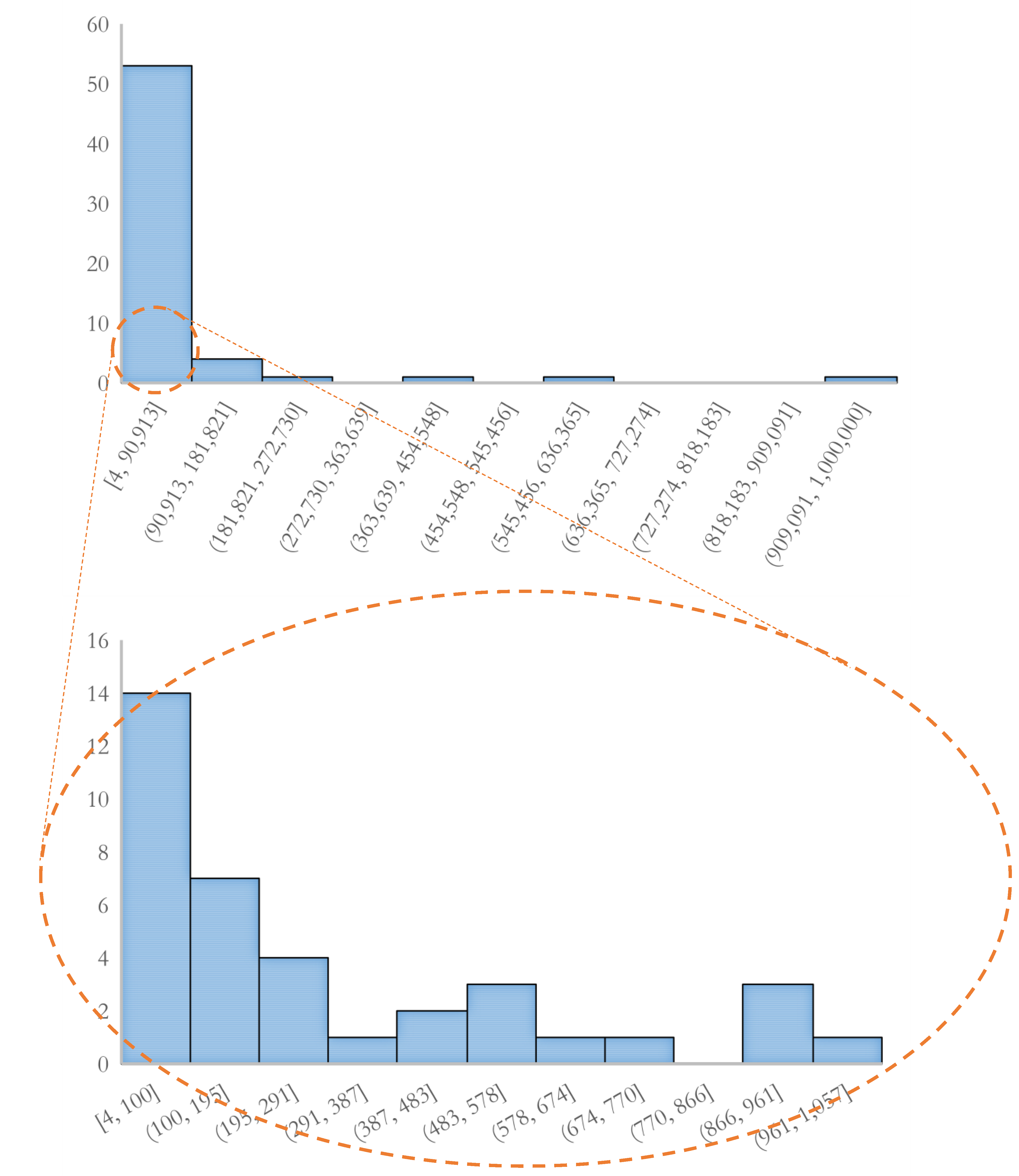

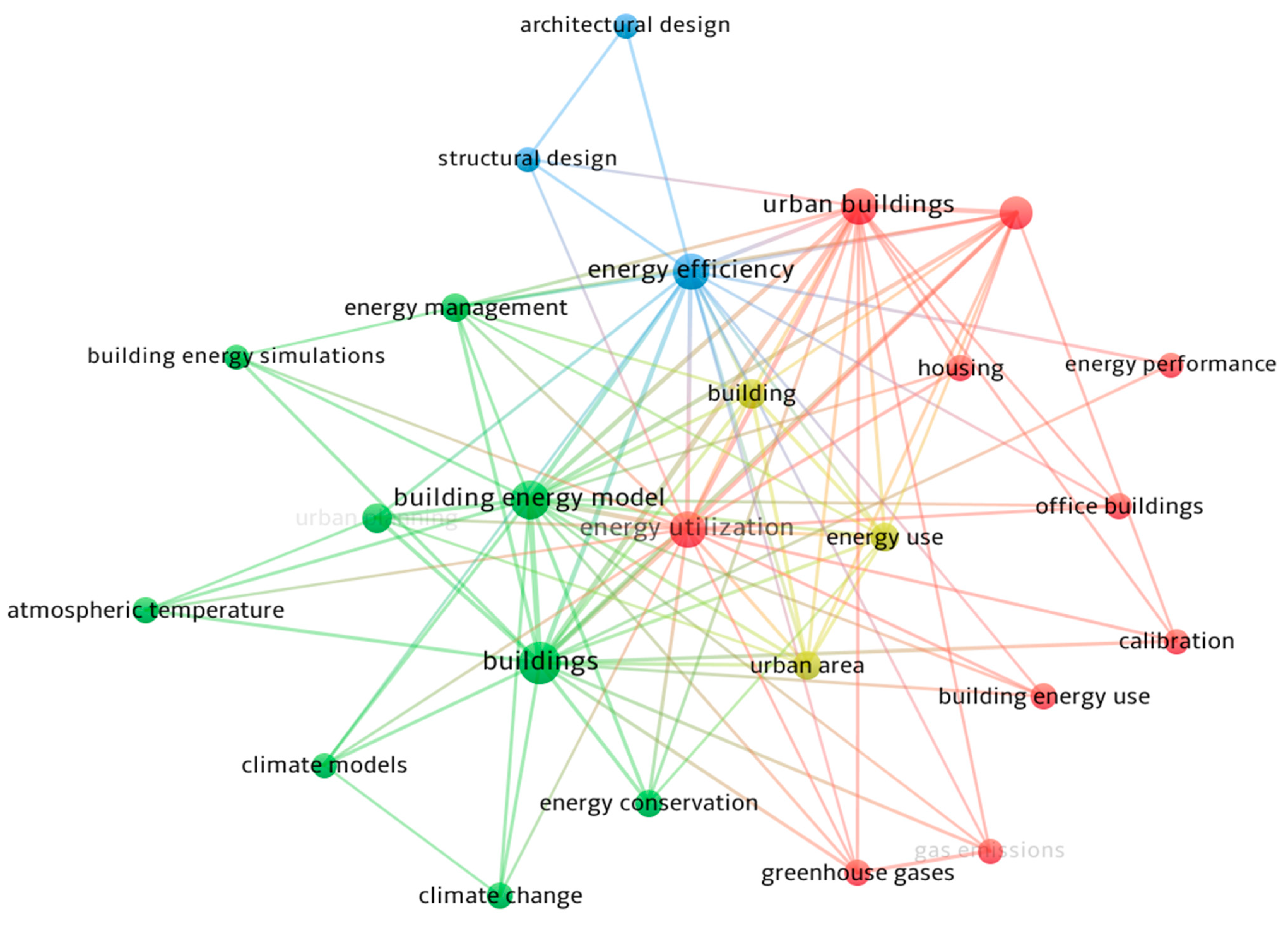




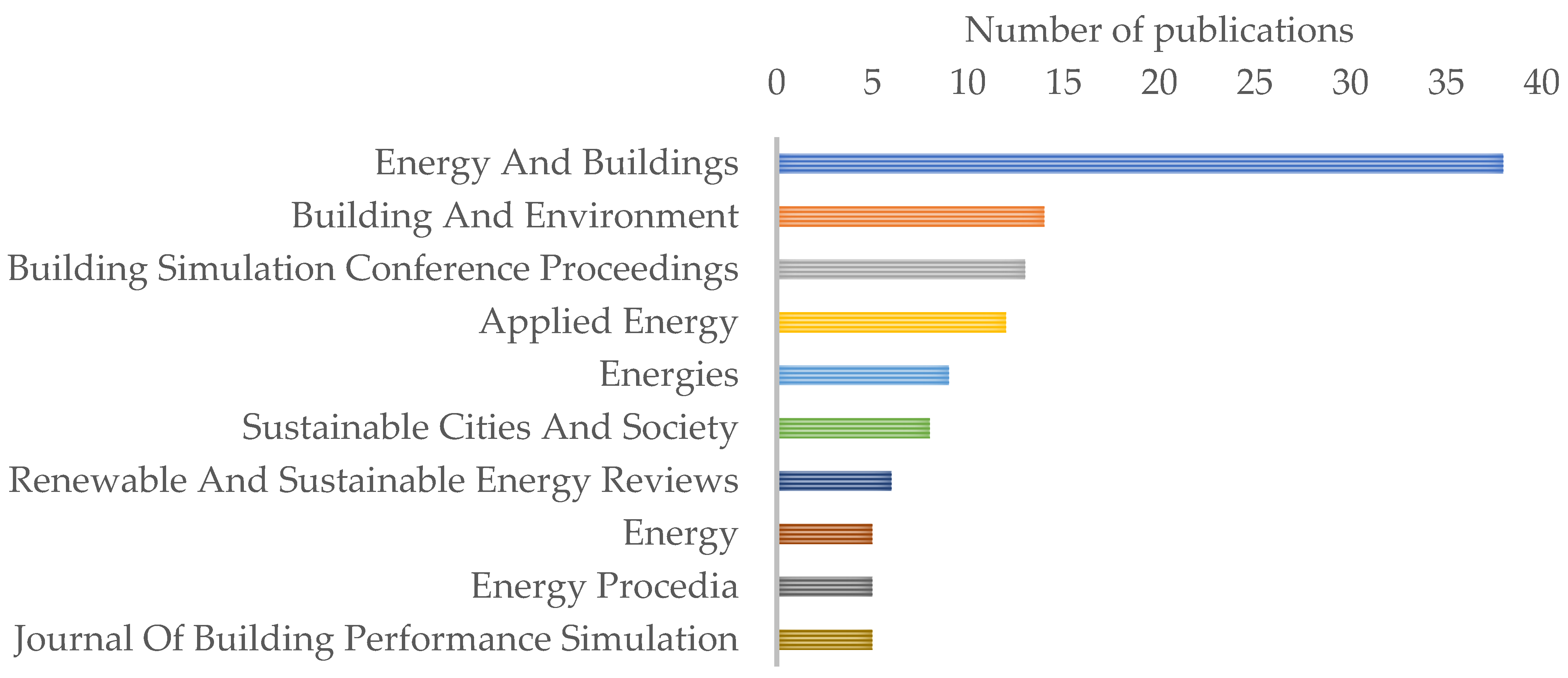
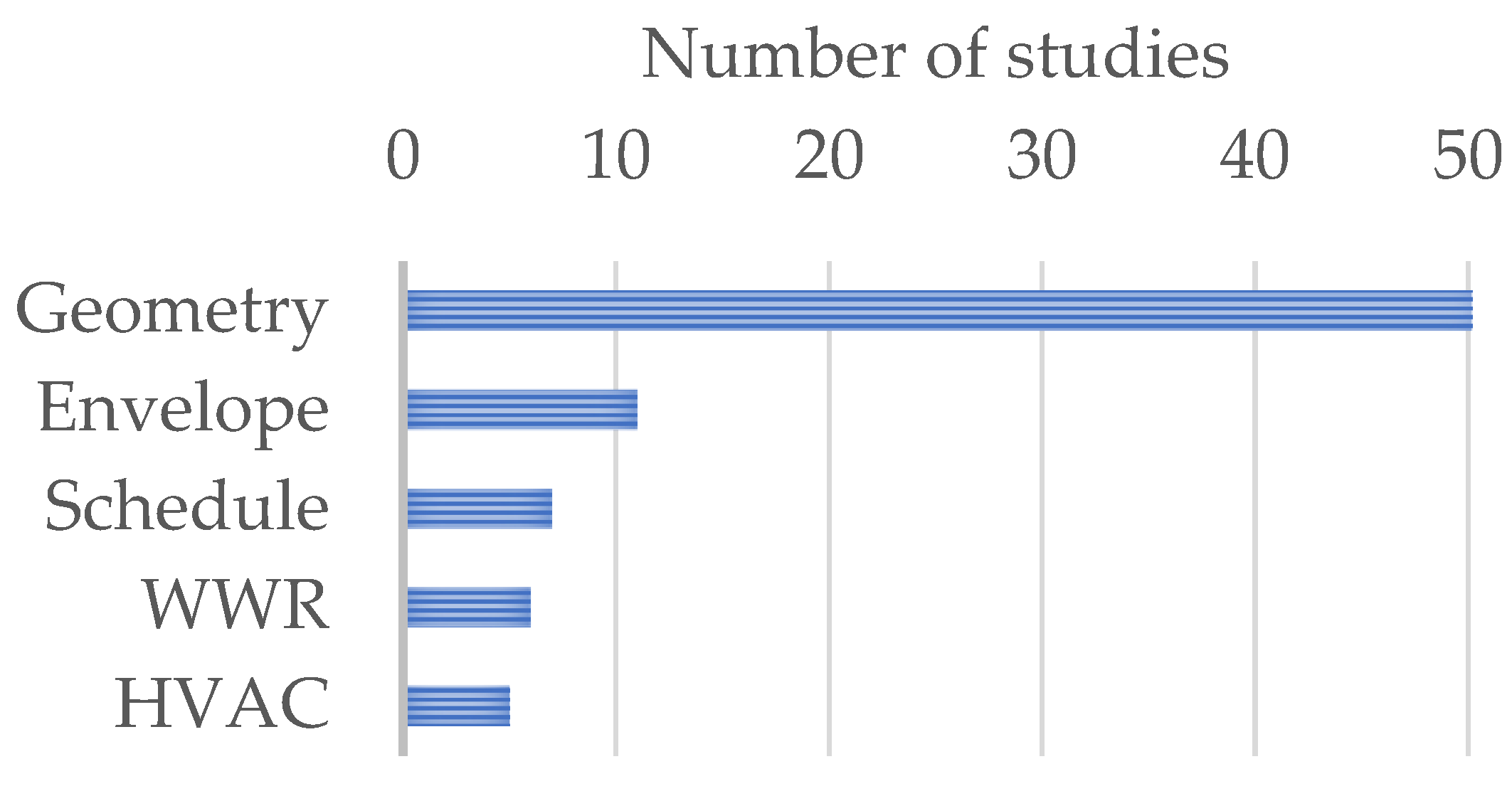

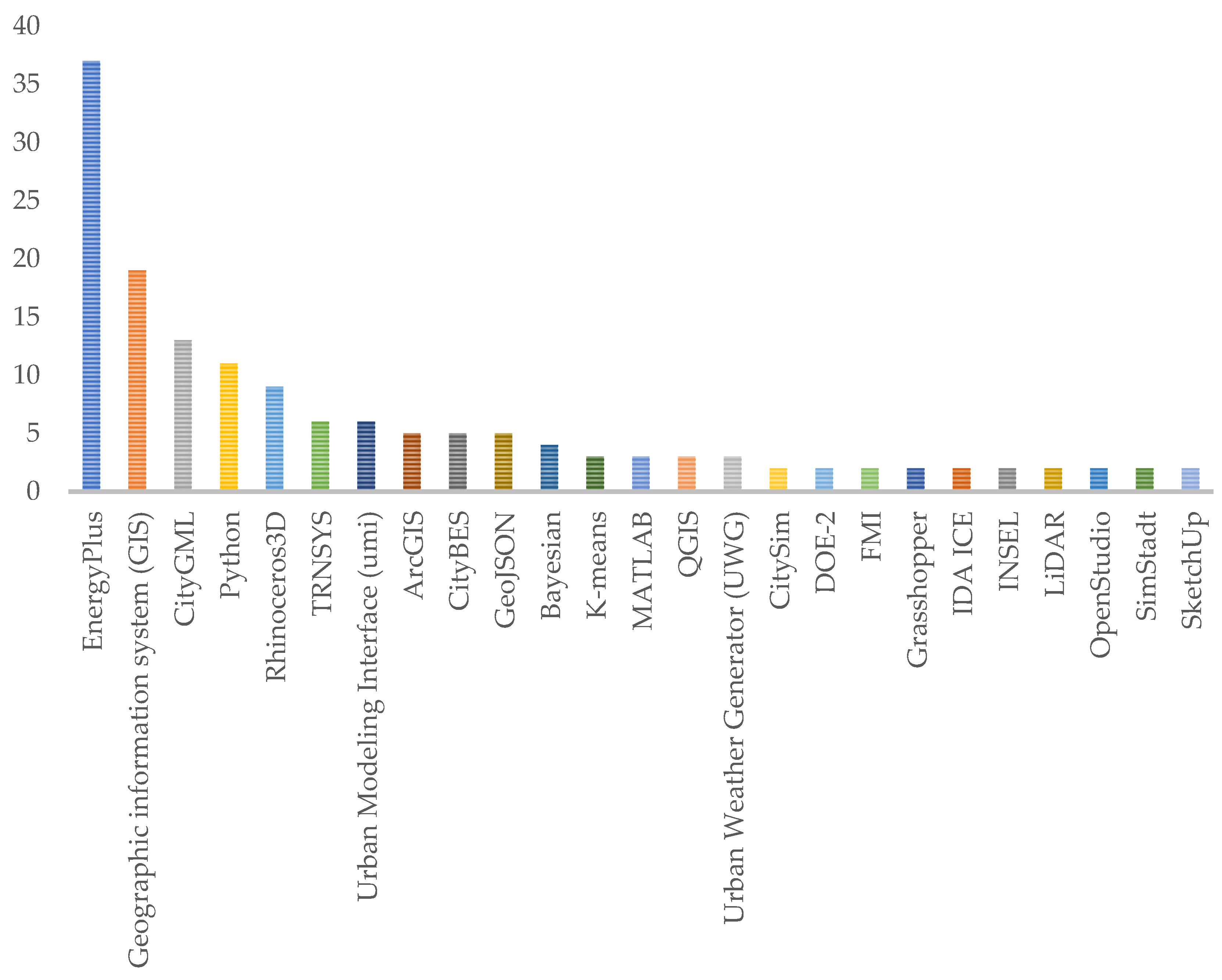

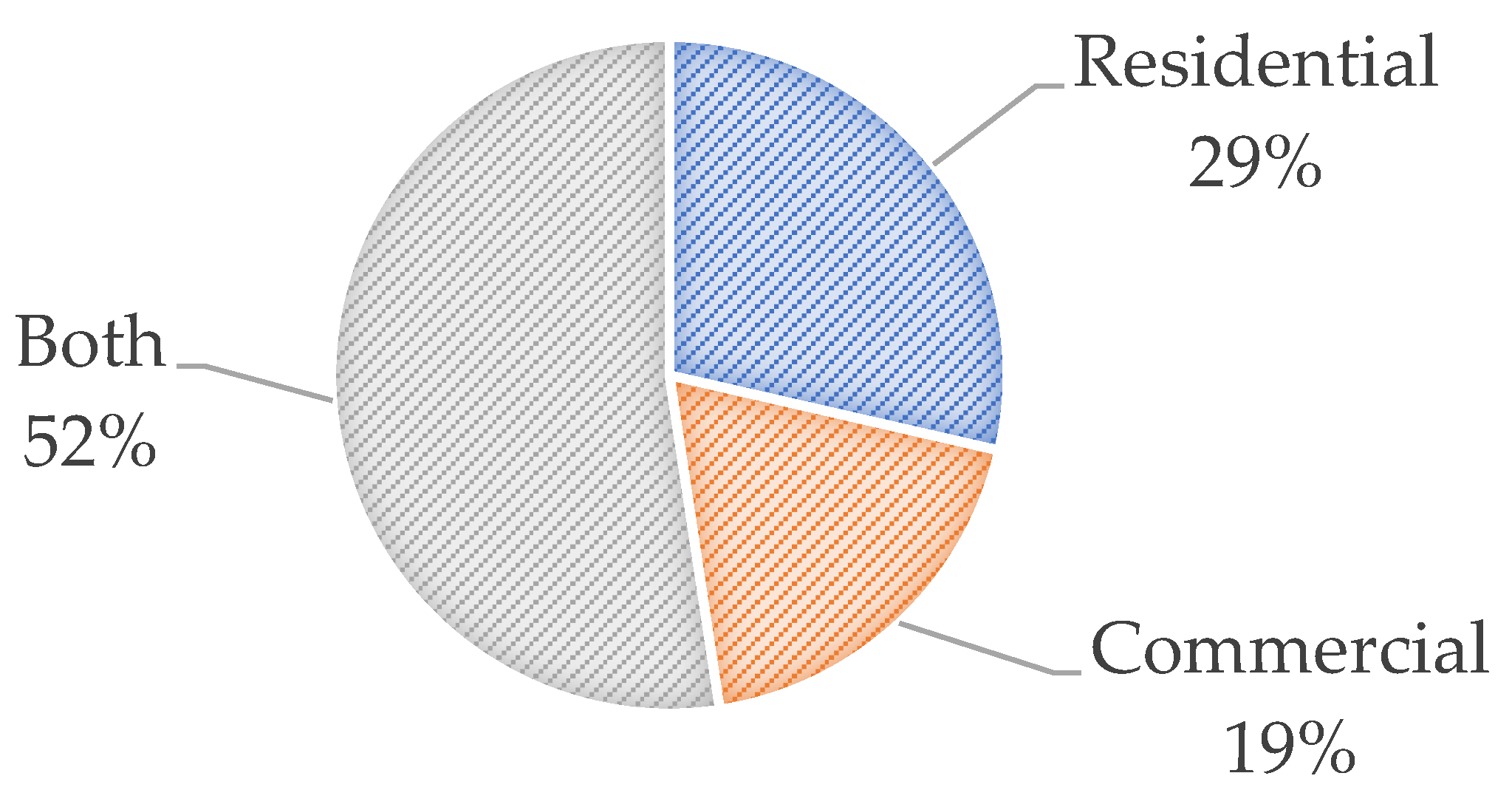
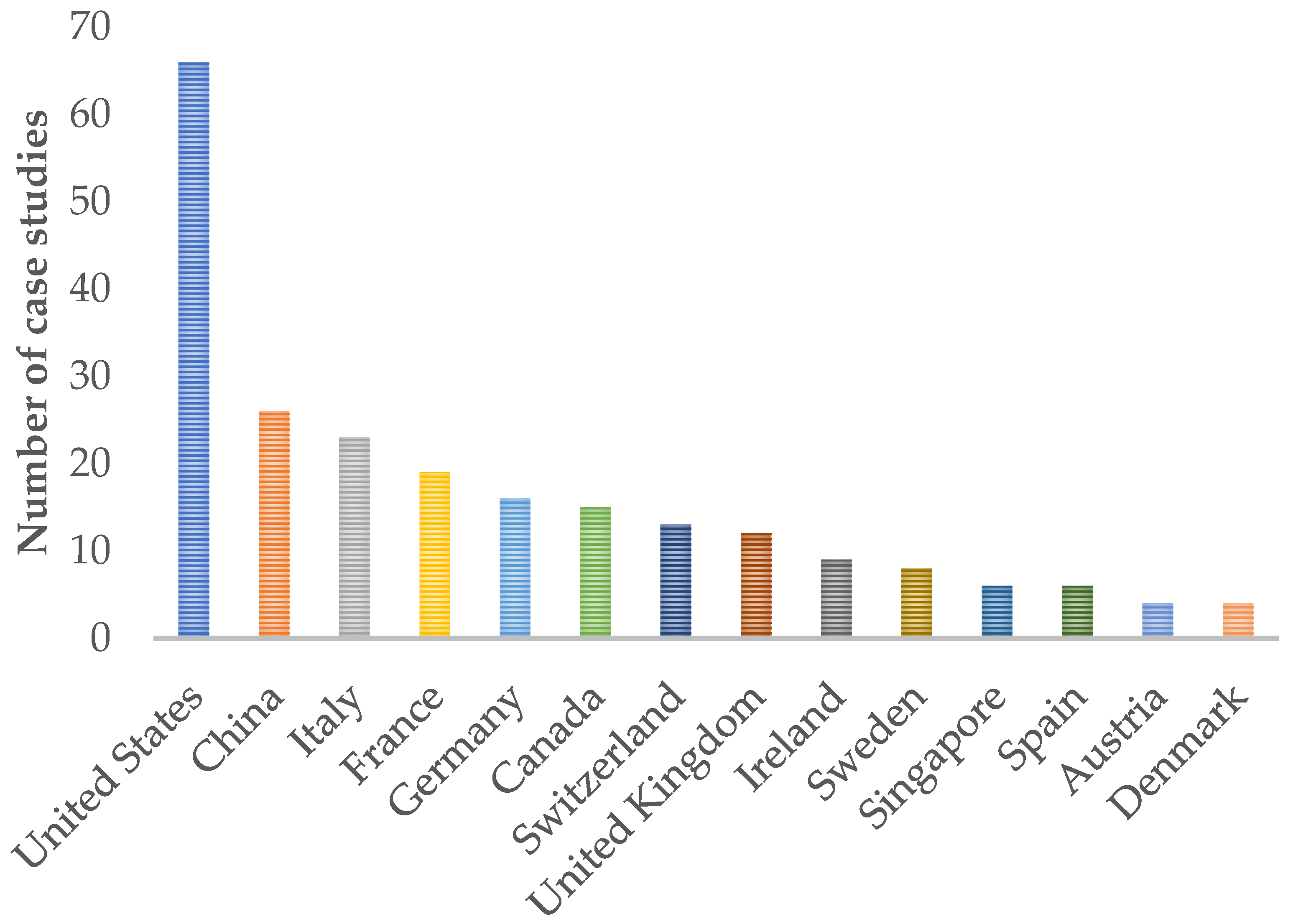
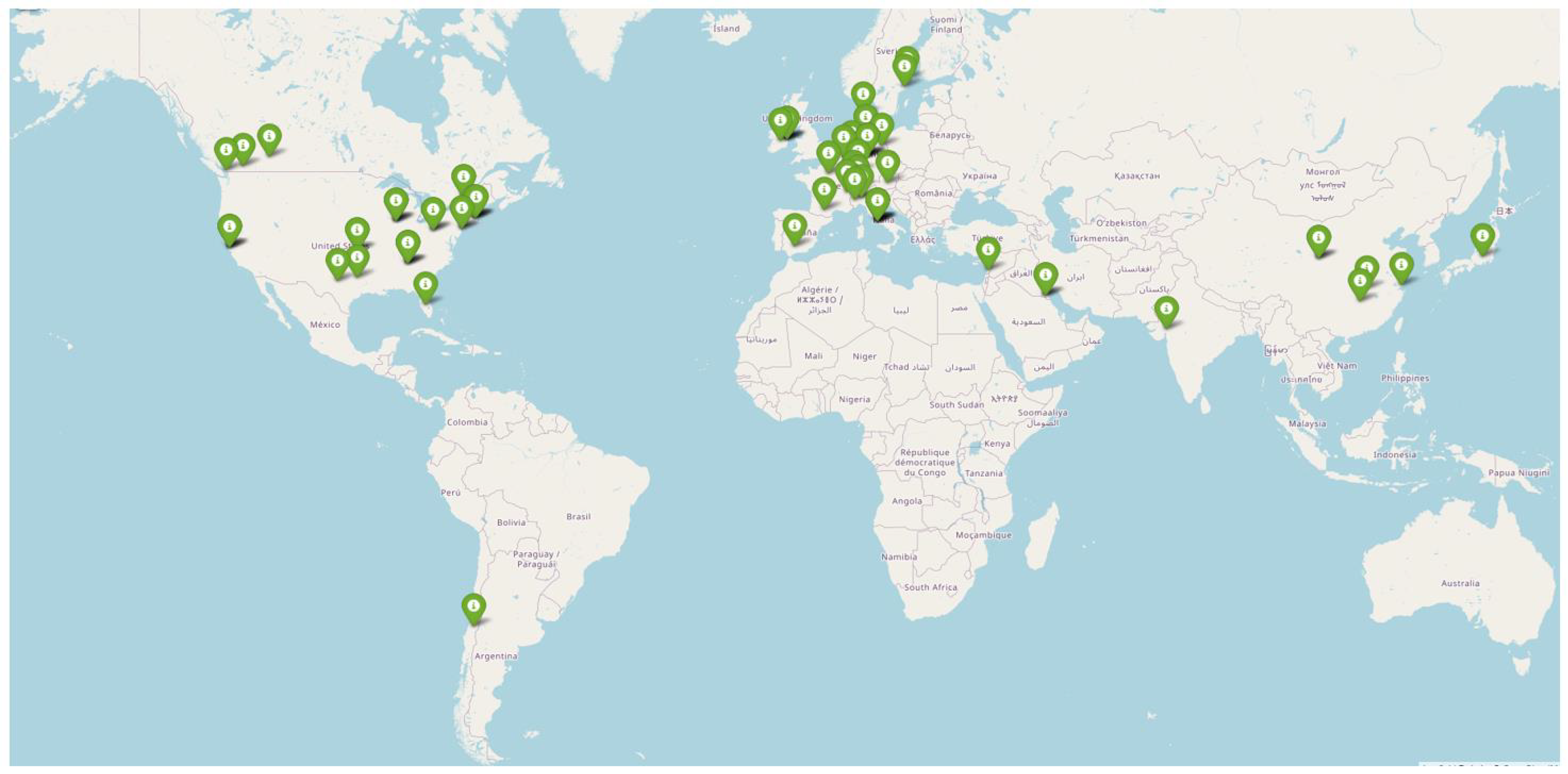
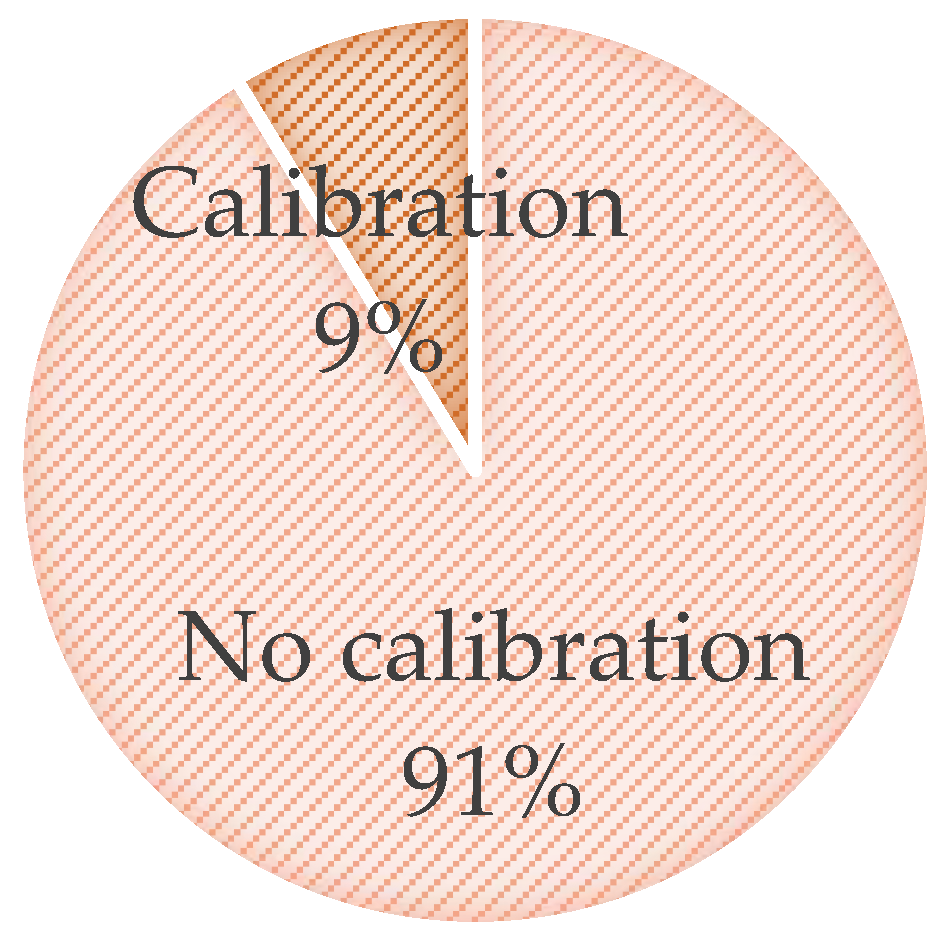

| Reference | UBEM Research Area |
|---|---|
| General Review | |
| [13] | Advancing urban building energy modeling through new model components and applications |
| [14] | Bottom-up physics-based approaches in UBEM |
| [15] | Information modelling for urban building energy simulation |
| [16] | AUBEM modeling approaches and procedures |
| [17] | State-of-the-art and prospects in urban building energy modeling |
| [18] | Ten questions on urban building energy modeling |
| [19] | The nascent field of urban building energy modeling |
| [20] | UBEM methods and tools using qualitative and quantitative analysis |
| [5] | Use cases in urban building energy modeling |
| UBEM tools | |
| [21] | A comparison of available tools in urban building energy modeling |
| [22] | UBEM tools |
| [23] | UBEM tools for district-scale energy systems |
| Occupant-centric | |
| [24] | Approaches, inputs, and data sources in occupant-centric urban building energy modeling |
| [25] | Occupant behavior in urban building energy models |
| Data acquisition | |
| [26] | Data acquisition for urban building energy modeling |
| [27] | GIS Data Extraction and Visualization to Support Urban Building Energy Modeling |
| [28] | Infrared thermography in the built environment |
| Classification and archetype development | |
| [29] | Archetype development strategies for energy assessment at the urban scale |
| [30] | Developing a common approach for classifying building stock energy models |
| Energy conservation potentials | |
| [31] | Energy saving potential for large-scale building |
| [32] | Estimating the energy-saving potential in national building stocks |
| Accuracy and calibration | |
| [6] | Accuracy of Urban Building Energy Modeling |
Publisher’s Note: MDPI stays neutral with regard to jurisdictional claims in published maps and institutional affiliations. |
© 2022 by the author. Licensee MDPI, Basel, Switzerland. This article is an open access article distributed under the terms and conditions of the Creative Commons Attribution (CC BY) license (https://creativecommons.org/licenses/by/4.0/).
Share and Cite
Kamel, E. A Systematic Literature Review of Physics-Based Urban Building Energy Modeling (UBEM) Tools, Data Sources, and Challenges for Energy Conservation. Energies 2022, 15, 8649. https://doi.org/10.3390/en15228649
Kamel E. A Systematic Literature Review of Physics-Based Urban Building Energy Modeling (UBEM) Tools, Data Sources, and Challenges for Energy Conservation. Energies. 2022; 15(22):8649. https://doi.org/10.3390/en15228649
Chicago/Turabian StyleKamel, Ehsan. 2022. "A Systematic Literature Review of Physics-Based Urban Building Energy Modeling (UBEM) Tools, Data Sources, and Challenges for Energy Conservation" Energies 15, no. 22: 8649. https://doi.org/10.3390/en15228649
APA StyleKamel, E. (2022). A Systematic Literature Review of Physics-Based Urban Building Energy Modeling (UBEM) Tools, Data Sources, and Challenges for Energy Conservation. Energies, 15(22), 8649. https://doi.org/10.3390/en15228649






